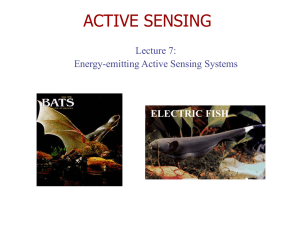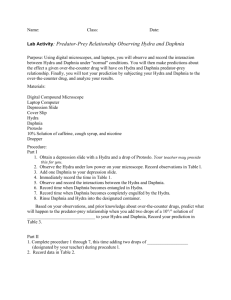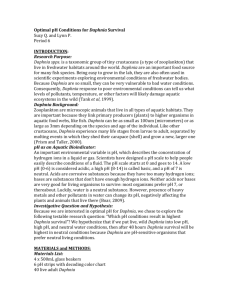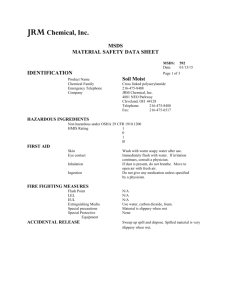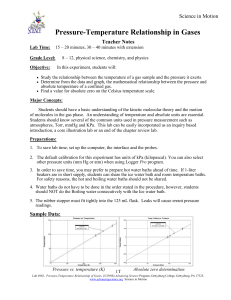Effect of Environmental Toxins on Daphnia
advertisement
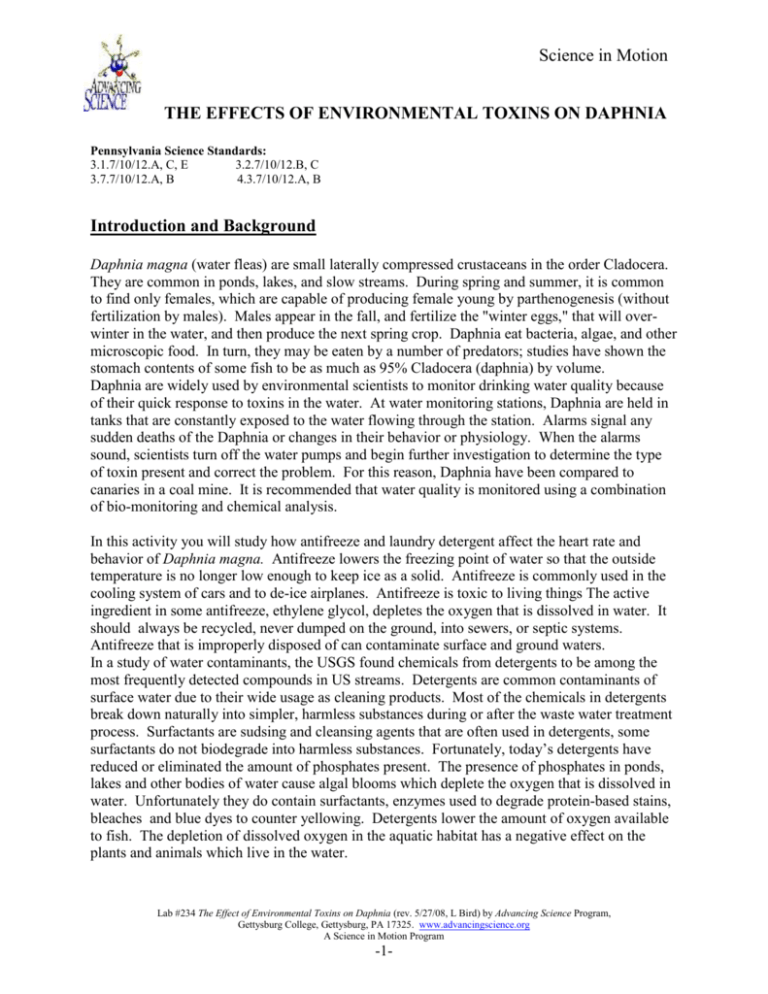
Science in Motion THE EFFECTS OF ENVIRONMENTAL TOXINS ON DAPHNIA Pennsylvania Science Standards: 3.1.7/10/12.A, C, E 3.2.7/10/12.B, C 3.7.7/10/12.A, B 4.3.7/10/12.A, B Introduction and Background Daphnia magna (water fleas) are small laterally compressed crustaceans in the order Cladocera. They are common in ponds, lakes, and slow streams. During spring and summer, it is common to find only females, which are capable of producing female young by parthenogenesis (without fertilization by males). Males appear in the fall, and fertilize the "winter eggs," that will overwinter in the water, and then produce the next spring crop. Daphnia eat bacteria, algae, and other microscopic food. In turn, they may be eaten by a number of predators; studies have shown the stomach contents of some fish to be as much as 95% Cladocera (daphnia) by volume. Daphnia are widely used by environmental scientists to monitor drinking water quality because of their quick response to toxins in the water. At water monitoring stations, Daphnia are held in tanks that are constantly exposed to the water flowing through the station. Alarms signal any sudden deaths of the Daphnia or changes in their behavior or physiology. When the alarms sound, scientists turn off the water pumps and begin further investigation to determine the type of toxin present and correct the problem. For this reason, Daphnia have been compared to canaries in a coal mine. It is recommended that water quality is monitored using a combination of bio-monitoring and chemical analysis. In this activity you will study how antifreeze and laundry detergent affect the heart rate and behavior of Daphnia magna. Antifreeze lowers the freezing point of water so that the outside temperature is no longer low enough to keep ice as a solid. Antifreeze is commonly used in the cooling system of cars and to de-ice airplanes. Antifreeze is toxic to living things The active ingredient in some antifreeze, ethylene glycol, depletes the oxygen that is dissolved in water. It should always be recycled, never dumped on the ground, into sewers, or septic systems. Antifreeze that is improperly disposed of can contaminate surface and ground waters. In a study of water contaminants, the USGS found chemicals from detergents to be among the most frequently detected compounds in US streams. Detergents are common contaminants of surface water due to their wide usage as cleaning products. Most of the chemicals in detergents break down naturally into simpler, harmless substances during or after the waste water treatment process. Surfactants are sudsing and cleansing agents that are often used in detergents, some surfactants do not biodegrade into harmless substances. Fortunately, today’s detergents have reduced or eliminated the amount of phosphates present. The presence of phosphates in ponds, lakes and other bodies of water cause algal blooms which deplete the oxygen that is dissolved in water. Unfortunately they do contain surfactants, enzymes used to degrade protein-based stains, bleaches and blue dyes to counter yellowing. Detergents lower the amount of oxygen available to fish. The depletion of dissolved oxygen in the aquatic habitat has a negative effect on the plants and animals which live in the water. Lab #234 The Effect of Environmental Toxins on Daphnia (rev. 5/27/08, L Bird) by Advancing Science Program, Gettysburg College, Gettysburg, PA 17325. www.advancingscience.org A Science in Motion Program -1- Science in Motion Guiding Questions: How will depleted or reduced oxygen levels in water affect the heart rate of daphnia? How will detergent or antifreeze affect the heart rate of daphnia? Why are daphnia helpful to study regarding pollutants in our streams, lakes and rivers? Vocabulary: Antifreeze- a substance added to a solvent, such as water, to lower its freezing point. Antifreeze is typically added to water in the cooling system of an internal-combustion engine so that it can be cooled below the freezing point of pure water (32 degrees F) without freezing. Detergent- a cleansing agent which may include synthetic or soap products Surfactants- sudsing and cleansing agents that are commonly used in detergent Dissolved oxygen (DO)- the amount of oxygen dissolved in water. The dissolved oxygen concentration in water can directly affect reproduction, incubation, changes in species, and death of adult and juvenile fish and other organisms. Safety: Detergent and antifreeze are harmful if ingested. Materials Needed (per group): Compound microscope Depression slides Live Daphnia Culture Stopwatch or timer Tally counter Antifreeze-50% solution Laundry Detergent-1% Procedure: Lab #234 The Effect of Environmental Toxins on Daphnia (rev. 5/27/08, L Bird) by Advancing Science Program, Gettysburg College, Gettysburg, PA 17325. www.advancingscience.org A Science in Motion Program -2- Science in Motion Experimental Roles Timer/Observer- observes behavior, times heart rate trials, and records heart rate data Counter- counts heartbeats and records behavior which is noted by Timer/Observer Do not switch roles during the procedure. Students may have different ways of counting the heart rate. This will affect the accuracy of your results! 1. Obtain a clean depression slide, and transfer a daphnia into the depression using a Pasteur pipette. Use enough water to cover the daphnia. 2. Observe the Daphnia under low power, center it in the field of view, focus, and examine the entire animal. Locate the heart, legs, antennae, and eye (use the daphnia diagrams provided by your instructor as a guide). 3. The Timer/Observer will observe the Daphnia’s behavior under normal conditions. This data will give you a baseline for comparison, enter the behavioral data under “Control condition” in Table 1. When observing your daphnia, note the heartbeat (do not count heart rate-simply observe its normal appearance), eye movement, leg movement, and antenna movement. Use the symbols listed above the observations table to indicate the daphnia’s behavior. Your first observations will indicate normal behavior and should be denoted as N. 4. The Counter will use a stopwatch to time the heart rate of the Daphnia on your slide. Click the tally counter once for each heart beat. If a tally counter is not available, use a pencil to make a dot on a piece of paper for every heart beat, and then count the dots. 5. Count the number of beats in 6 seconds and multiply by 10. This will provide the beats/minute. Repeat this procedure for a total of 6 trials (if time is available) and average the results. Record your “Control condition” results in Table 2. 6. As soon as you have finished your last control condition heart rate count, turn off the microscope light. The light produces heat which affects the Daphnia. 7. Choose an environmental toxin (antifreeze or laundry detergent) to test on the Daphnia. 8. Write a hypothesis stating what you think will happen to the animal’s behavior and heart rate. 9. Add 1 drop of the selected toxin to the Daphnia’s slide. Note the time the toxin was added on your data sheet. Wait 1minute. 10. Turn on the microscope light. Observe and record the Daphnia’s behavior.. 11. Two minutes following treatment measure the Daphnia’s heart rate for 6 seconds, Repeat 6 times. 12. Continue observing the behavior and taking heart rate measurements as indicated on the data tables. The Effects of Environmental Toxins on Daphnia Lab #234 The Effect of Environmental Toxins on Daphnia (rev. 5/27/08, L Bird) by Advancing Science Program, Gettysburg College, Gettysburg, PA 17325. www.advancingscience.org A Science in Motion Program -3- Science in Motion Observation and Data Record Sheet EXPERIMENT TITLE: __________________________________________________________________ (Create an appropriate title for your experiment) HYPOTHESIS FOR ______________________________: (toxin) __________________________________________________________________________________________ Table 1: Behavioral Observations Normal → N Control Condition Behavior Decreased → (―) Increased→ ( +) Treatment time Treatment time + 1’ Irregular/Erratic → I Treatment time +4’ Treatment time + 9’ Treatment time + 14’ Treatment time +19’ Time Heart rate ******* Eye Movement Gill and Leg Movement Antenna Movement ******* ******* ******* Table 2: Heart Rate (BPM) Trial # Control Condition Time ****** 1 2 3 4 5 6 Avg Treatment time Treatment time + 2’ Treatment time +6’ Treatment time + 10’ Treatment time + 15’ Treatment Time +20’ ****** ****** ***** ***** ***** ***** ***** Lab #234 The Effect of Environmental Toxins on Daphnia (rev. 5/27/08, L Bird) by Advancing Science Program, Gettysburg College, Gettysburg, PA 17325. www.advancingscience.org A Science in Motion Program -4- Science in Motion 360 Questions: 320 Analysis & Conclusions: 1. Graph your average heart rate results. 280 Heart Rate (BPM) 240 200 160 120 80 40 20 min 15 min 10 min 5 min 2 min Pretreat 0 Time Following Treatment 2. Summarize the results of your experiment. Using your data detrmine the behavioral effects and changes in heart rate due to the toxins. Why do you think these changes occurred? __________________________________________________________________________________________ __________________________________________________________________________________________ __________________________________________________________________________________________ Lab #234 The Effect of Environmental Toxins on Daphnia (rev. 5/27/08, L Bird) by Advancing Science Program, Gettysburg College, Gettysburg, PA 17325. www.advancingscience.org A Science in Motion Program -5- Science in Motion 3. List 3 sources of error that may have affected the results of your experiment. List possible changes in procedure to reduce the source of the error. Source of Error Possible improvement to Procedure Optional Calculations Percent Change Equation This equation can be used to allow better comparison of individual results to others in the classroom. % Change = Treatment Time Heart Rate – Control Heart Rate X 100 Control Heart Rate Percent Change Data Table Average (BPM) Control (Average – Control Average) X 100 Control Average *********N/A******** Treatment +2’ Treatment +6’ Treatment +10’ Treatment + 15’ Treatment + 20’ Lab #234 The Effect of Environmental Toxins on Daphnia (rev. 5/27/08, L Bird) by Advancing Science Program, Gettysburg College, Gettysburg, PA 17325. www.advancingscience.org A Science in Motion Program -6- Science in Motion The Effect of Environmental Toxins on Daphnia Teacher Notes Set Up Time: 40-60 minutes Time needed to complete the lab: 45-50 minutes Target Grade Level: 6-12, Biology, Environmental Sciences Objectives: 1. Students will understand the physiological effects of common environmental toxins on the heart rate and behavior of in daphnia. 2. Students will collect and analyze heart rate data. 3. Students will understand the role of daphnia in bio-monitoring and the food web. 4. Students will practice proper use of compound microscope. Major Concepts: The effect of common pollutants on aquatic animals. The impact of toxins entering a small organism and its effect on the food web. The impact of pollutants on the watershed. Additional Resources: Advancing Science Activity #230, Introduction to the Compound Microscope . This lab will instruct the students how to use the microscopes using prepared slides. Preparation: Antifreeze: Prestone antifreeze (50% antifreeze, 50% water) is provided with the AS equipment. The active ingredient is ethylene glycol. Laundry Detergent: Sam’s choice color safe laundry detergent (1% Solution – diluted with pond water) is provided with the AS equipment. This detergent contains no phosphorus. Answers to Questions: 1. Graph average heart rate. Results may vary but should reflect the information in question number 2. 2. Summarize the results of your experiment. What were the behavioral effects and changes in heart rate. Why do you think these changes occurred? Typical Results: Antifreeze: The antifreeze initially showed an increase in HR. After about 8-12 minutes, the HR became very irregular and shallow, BPM normally remains increased before dropping after 12 minutes. Around this same time period, the daphnia appeared to be in paralysis while the heart continued to beat in an irregular manner. Laundry Detergent: The laundry detergent showed a steady decrease in HR. The daphnia’s behavior was normal throughout except for a slight decrease in movement as the HR decreased. Lab #234 The Effect of Environmental Toxins on Daphnia (rev. 5/27/08, L Bird) by Advancing Science Program, Gettysburg College, Gettysburg, PA 17325. www.advancingscience.org A Science in Motion Program -7- Science in Motion 3 List 3 sources of error that may have affected the results of your experiment. List possible changes in procedure to reduce the source of the error. Source of Error Possible improvement to Procedure Increase number of trials; practice a number of times before beginning data collection Use more exact delivery system of toxin; use equal amounts of pond water for each daphnia Use only daphnia of equal size; use only healthy fast swimming daphnia. Human error in counting beats Concentration of toxin present on daphnia slide Daphnia size or health References Patel-Predd, P. (2006). Dead Daphnia Flag Mystery Water Contaminants. Environmental Science & Technology Online, 40, 10. Retrieved May 25, 2006 from http://pubs.acs.org/subscribe/journals/esthag-w/2006/mar/tech/pp_deadfly.html Kolpin, D.W. et al. (2002). Pharmaceuticals, Hormones, and Other Organic Wastewater Contaminants in U.S. Streams, 1999-2000: A National Reconnaissance. Environmental Science & Technology, 36, 6. Retrieved June 22, 2006 from http://pubs.acs.org/cgi-bin/jtextd?esthag/36/6/html/es011055j.html Antifreeze Fact Sheet http://www.deq.state.or.us/wmc/hw/factsheets/UsedAntifreeze.pdf How Toxic Are Your Household Cleaning Supplies (included suggestions for alternatives) http://www.organicconsumers.org/2006/article_279.cfm Dissolved oxygen information http://www.coastal-watershed.org/CWC_Library/Water_Quality/index.htm Pre Lab Quiz Key 1. C 2. A 3. B 4. D 5. B Post Lab Quiz Key 1. C 2. B 3. B 4. C 5. C Pennsylvania Science Standards: 3.1.7/10/12.A, C, E 3.2.7/10/12.B, C 3.7.7/10/12.A, B 4.3.7/10/12.A, B The Effect of Environmental Toxins on Daphnia was written by Valerie Stone and Lesa Bird for the Advancing Science Program at Gettysburg College, Gettysburg, PA 17325 http://www.advancingscience.org Lab #234 The Effect of Environmental Toxins on Daphnia (rev. 5/27/08, L Bird) by Advancing Science Program, Gettysburg College, Gettysburg, PA 17325. www.advancingscience.org A Science in Motion Program -8- Science in Motion Pre-Lab Quiz Name_________________________________Period_______School________________________________ 1. Antifreeze, when found in a lake or stream, will: A. Be beneficial by helping to regulate the water temperature. B. Have no effect on aquatic life. C. Have a harmful effect on small and large forms of aquatic life. D. Provide a good food source for aquatic life 2. Why are daphnia, a small crustacean, an important animal to observe regarding pollutants in our bodies of water? A. They are a common food source for larger aquatic life. B. They are easily captured. C. They are not eaten by other animals. D. They reproduce quickly. 3. Low levels of dissolve oxygen in streams and lakes can: A. Improve the health of aquatic organisms. B. Harm the health of aquatic organisms. C. Allow less sunlight to filter thru the water. D. Promote good plant growth. 4. Daphnia response to pollutants can be seen as a change in their: A. Appetite B. Color C. Length D. Heart Rate 5. What is one of the most common pollutants found in our lakes, streams and river? A. Manure B. Detergents C. Dead animals D. Gasoline Lab #234 The Effect of Environmental Toxins on Daphnia (rev. 5/27/08, L Bird) by Advancing Science Program, Gettysburg College, Gettysburg, PA 17325. www.advancingscience.org A Science in Motion Program -9- Science in Motion Post-Lab Quiz Name_________________________________Period_______School________________________________ 1. Why are daphnia, a small crustacean, an important animal to observe regarding pollutants in our bodies of water? A. They are easily captured. B. They are not eaten by other animals. C. They are a common food source for larger aquatic life. D. They reproduce quickly. 2. Daphnia response to pollutants can be seen as a change in their: A. Length B. Heart Rate C. Appetite D. Color 3. Antifreeze, when found in a lake or stream, will: A. Be beneficial by helping to regulate the water temperature. B. Have a harmful effect on small and large forms of aquatic life. C. Provide a good food source for aquatic life. D. No effect on aquatic life. 4. Low levels of dissolve oxygen in streams and lakes can: A. Promote good plant growth. B. Allow less sunlight to filter thru the water. C. Harm the health of aquatic organisms. D. Improve the health of aquatic organisms. 5. What is one of the most common pollutants found in our lakes, streams and river? A. Manure B. Dead animals C. Detergents D. Gasoline Lab #234 The Effect of Environmental Toxins on Daphnia (rev. 5/27/08, L Bird) by Advancing Science Program, Gettysburg College, Gettysburg, PA 17325. www.advancingscience.org A Science in Motion Program -10-

